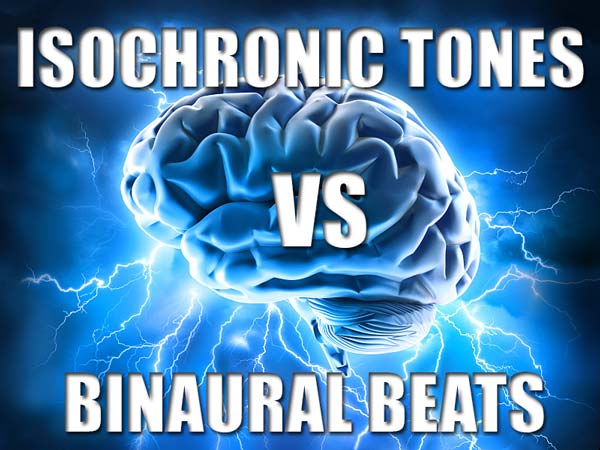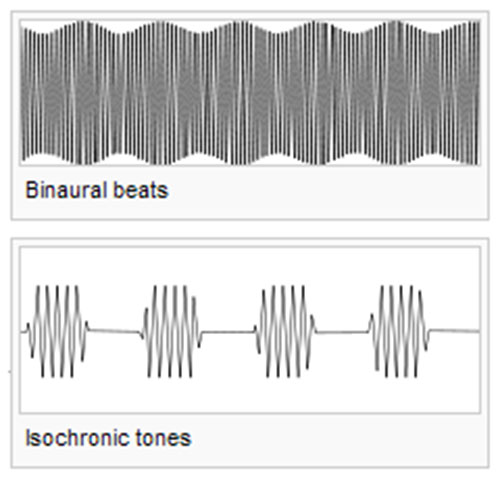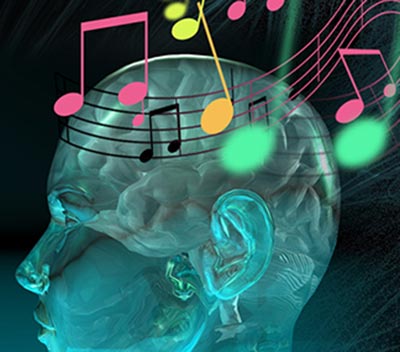Brainwave entrainment technologies have gained significant popularity in recent years, with isochronic tones and binaural beats emerging as the two primary options available in the market.
Both methods offer intriguing possibilities for enhancing various aspects of human experience, but understanding how they work and determining which one is more effective can be perplexing. Furthermore, selecting the technology that aligns best with your specific needs and preferences can feel overwhelming.
However, fear not, for I am here to lend you a helping hand.
In this article, I will delve into the intricacies of isochronic tones and binaural beats, unraveling the key differences and shedding light on their respective strengths and weaknesses.
By exploring the distinctions between these two brainwave entrainment techniques, you will gain valuable insights to guide your decision-making process, ultimately enabling you to choose the approach that harmonizes most harmoniously with your auditory senses.

Isochronic Tones vs Binaural Beats
1. Binaural Beats
Binaural beats technology is the pioneering and enduring frontrunner in the realm of brainwave entrainment. This format has maintained a dominant position in the market for a very long time. Renowned for their effectiveness, binaural beats consistently emerge as the preferred choice among enthusiasts.
The underlying mechanism behind binaural beats revolves around the delivery of distinct frequencies to each ear. By presenting two slightly different frequencies simultaneously, the brain is stimulated to generate a third tone equal to the mathematical difference between the two frequencies.
To illustrate this concept, consider the scenario where a 310 Hertz frequency is directed to the left ear and a 315 Hertz frequency to the right ear. In response, the brain seamlessly integrates and processes these inputs, resulting in the perception of a single tone with a frequency of 5 Hz.
Subsequently, the brain gracefully synchronizes with this novel frequency, entraining its own brainwave activity to mirror the rate of 5 Hz. This remarkable phenomenon, scientifically referred to as the “frequency following response,” exemplifies the brain's remarkable capacity to adapt and align its neural oscillations with external stimuli (Source: Binauralbeatsmeditation.com).
The extensive body of research conducted on binaural beats technology has consistently demonstrated its efficacy in influencing brainwave patterns and eliciting desired mental states. Numerous studies have confirmed the ability of binaural beats to induce relaxation, enhance focus, reduce pain perception, and promote sleep. This solid foundation of empirical evidence has solidified the position of binaural beats as the go-to choice for many individuals seeking the benefits of brainwave entrainment.
The Pros:
- Scientifically Validated Effectiveness: The efficacy of this technology has received substantial validation through extensive scientific studies. Its ability to induce desired effects on brainwave activity has been rigorously examined, providing a solid foundation of evidence for its effectiveness.
- Time-Tested Reliability: With a history spanning many years, this technology has established a reputation for reliability and longevity. Its enduring presence in the field of brainwave entrainment signifies its ability to consistently deliver desired outcomes over time.
- Vast Range of Choices: Users have access to an expansive array of options within this technology. With numerous choices available, individuals can explore diverse variations and tailor their experience to suit their specific preferences and goals.
- High Effectiveness and Affordability: Not only does this technology boast high effectiveness in achieving desired brainwave states, but it also offers remarkable affordability. Online prices typically range from $7.99 to $12, making it accessible to a wide range of individuals seeking to explore the benefits of brainwave entrainment without breaking the bank.
The Cons:
- Headphone Requirement: To fully experience the benefits of this technology, the use of headphones is necessary. The stereo effect created by delivering specific frequencies to each ear plays a crucial role in achieving the desired brainwave entrainment effects.
- Beware of Low-Quality Programs: It is essential to exercise caution when seeking programs or recordings within this technology, especially on platforms like YouTube. The abundance of low-quality or misleading content can make it challenging to find reliable and effective resources. It is advisable to research and choose reputable sources that offer well-crafted and scientifically informed programs.
- Diminishing Effectiveness Beyond 50 Hz: It is worth noting that the effectiveness of this technology tends to diminish as the frequency exceeds approximately 50 Hz. While it remains highly effective within this range, its impact on brainwave entrainment becomes less pronounced when targeting higher frequency ranges.
3) Isochronic Tones
Isochronic tones technology, while relatively newer in terms of online popularity, has emerged as an alternative form of brainwave entrainment.
Unlike binaural beats, which employ two tones delivered separately to each ear, isochronic tones utilize a single tone. However, the distinguishing feature of isochronic tones lies in their pulsating pattern, where the tone repetitively turns on and off at a specific speed corresponding to the chosen frequency.
To put it frankly, isochronic tones are the “ugly cousin” of binaural beats due to their less aesthetically pleasing sound. Unlike the soothing and melodic hum of binaural beats, isochronic tones possess a more aggressive and pulsating quality, which can be off-putting for many individuals. This sonic disparity has led to mixed reactions, with some people finding it difficult to appreciate the auditory experience.
However, there are some advantages to isochronic tones that deserve consideration. Notably, unlike binaural beats, isochronic tones do not require the use of headphones to reap their benefits. This feature can be appealing for those who prefer not to wear headphones or find them uncomfortable. The convenience of not needing additional audio equipment can be a significant factor for some people.
When it comes to scientific evidence, it is important to note that studies in the field of brainwave entrainment predominantly focus on binaural beats as the primary technology. As a result, there is limited scientific research specifically dedicated to examining the efficacy of isochronic tones.
However, anecdotal experiences and user feedback suggest that isochronic tones may excel in the higher frequency ranges, such as Beta and Gamma, where binaural beats show diminishing effectiveness beyond approximately 50 Hz. On the other hand, isochronic tones are not thought to be as effective for entrainment in the lower frequency ranges, such as Delta and Theta.
It is worth mentioning that the practicality of not requiring headphones can be debated. While it may seem advantageous at first, some people find that to experience the pronounced effects of isochronic tones, they need to be in close proximity to the speakers. This may not be practical in various settings, prompting the use of headphones regardless.
Additionally, for those engaging in brainwave entrainment during work or in a noisy environment, the use of headphones can help block out external distractions, enhancing the overall experience.
The Pros
- Headphone-free Experience: Unlike binaural beats, isochronic tones can be enjoyed without the need for headphones. This allows for a more open and inclusive listening experience, making it possible to share the benefits with others or listen in a group setting.
- Social Listening: With isochronic tones, you can enjoy the entrainment effects out loud with friends or in a social setting. This makes it conducive for group activities, relaxation sessions, or simply sharing the experience with others.
- Initial Impact: Many users report experiencing a powerful initial effect when using isochronic tones. The distinct pulsating pattern of the tones can create an immediate and noticeable impact on brainwave activity, providing a strong initial entrainment experience.
- Preference for Audible Frequencies: Isochronic tones appeal to brainwave entrainment enthusiasts who appreciate the tangible experience of hearing the frequencies pulsating in their ears. For those who are deeply interested in the intricacies of brainwave entrainment, isochronic tones offer a more pronounced auditory representation of the desired frequencies.
The Cons
- Audibility for Effective Entrainment: To ensure proper entrainment, isochronic tones recordings must have a significant auditory presence. The tones need to be clearly audible and discernible to achieve the desired brainwave synchronization. This emphasis on audibility distinguishes isochronic tones from other forms of brainwave entrainment.
- Less Pleasant Sound Compared to Binaural Beats: One notable characteristic of isochronic tones is that their sound is often perceived as less pleasant compared to the soothing tones of binaural beats. The pulsating nature of isochronic tones can be perceived as more aggressive or jarring by some people, potentially affecting the overall listening experience.
- Limited Entrainment in Lower Frequency Ranges: Isochronic tones may have limitations when it comes to entrainment in the lower frequency ranges, such as Theta and Delta brainwaves. Their effectiveness in inducing and maintaining the desired brainwave states in these frequency ranges may be relatively diminished compared to other technologies like binaural beats.
- Lack of Peer-Reviewed Research Studies: It's important to note that the effectiveness of isochronic tones lacks substantial support from peer-reviewed research studies. While anecdotal evidence and user experiences exist, the absence of scientific studies specifically dedicated to evaluating the efficacy of isochronic tones limits the ability to draw robust conclusions based on rigorous scientific investigation.
So Which is Better – Isochronic Tones or Binaural Beats?
The decision of whether to choose binaural beats or isochronic tones as your preferred method of brainwave entrainment ultimately comes down to personal preference and individual response.
While there are distinct differences between the two technologies, considering factors such as sound preferences, desired frequency ranges, and practicality will help guide this decision-making process.
For some, like myself, who have been using binaural beats from the beginning of their healing music journey, familiarity and a proven track record may contribute to a preference for this technology.
Binaural beats have demonstrated effectiveness in areas such as focus, pain relief, mood improvement, stress and anxiety relief, and more which align with my personal goals.
On the other hand, I have also explored isochronic tones, particularly in the gamma frequency range, and found them to be effective. However, I understand that the pulsating and aggressive sound of isochronic tones may not be well-received by everyone. I've encountered many people who cannot tolerate the sound.
Moreover, I have come to realize that wearing headphones during brainwave entrainment sessions enhances the overall experience, even when using isochronic tones, so it doesn't matter to me that you don't need to wear headphones to benefit from isochronic tones.
The direct delivery of frequencies to the ears through headphones seems to produce a stronger entrainment effect compared to listening through speakers, regardless of the technology. The alignment of sound directly with the ears appears to have a greater impact on brainwave synchronization, as opposed to inconsistent tones or sounds coming from a distance or speakers that are not precisely aligned with the hearing channel.
Additionally, the use of headphones provides a more immersive and focused experience, allowing me to enter my own headspace during sessions.
Where to Buy Your Binaural Beats and Isochronic Tones
In the realm of brainwave entrainment, experimentation is key. It is normal to encounter programs (recordings/tracks) that may not work well for you, while others become indispensable in your collection.
The most important factor is to determine what works best for you and curate a personalized collection based on that premise, rather than solely focusing on the type of technology used to create them.
Individual preferences vary greatly when it comes to binaural beats and isochronic tones. Some individuals swear by binaural beats and find it difficult to resonate with the sound of isochronic tones, while others experience a heightened sense of stimulation and enjoyment with isochronic tones, particularly at higher frequency levels.
A practical approach could involve using binaural beats for entrainment below 50 Hz. All the common use cases are usually quite low frequency, such as relaxation, stress and anxiety relief, focus, sleep, and pain relief. And then use isochronic tones high frequency purposes such as transcendental states, high-level cognitive function.
If you are new to the world of brainwave music, binaural beats would be the best effective entry point. However, regardless of the type of technology used, the quality of the production greatly impacts your experience. It is advisable to invest in professionally produced tracks to ensure a more reliable and impactful brainwave entrainment experience.
Please note that it is important to exercise caution when exploring this type of music content on platforms like YouTube. Much of the content available there may not align with its description, as many creators prioritize views rather than accurate representation.
Furthermore, the files played back through YouTube can be heavily compressed, significantly reducing the effectiveness of entrainment.
I highly recommend Binaural Beats Meditation. This company has been around for 15 years and is the mist popular. Their music is produced by professional musicians with experience in producing healing music. The compositions are really nice to listen to, as they harmoniously integrate the binaural beats frequencies under the music so it is often unnoticeable. They offer good value and great customer service.
+ Click here to go to BinauralBeatsMeditation.com
There aren't many options for buying isochronic tones, but Unexplainable Store is a good bet. Len has run the store for many years and provides a good service. Unexplainable Store caters to the more metaphysical and mystical aspects of brainwave entrainment – topics like spirit guides, remote viewing, chanting, and more.
+ Click here to go to Unexplainable Store
——
Well, that's it. I hope this has helped you get a handle on the differences between these two technologies. Do stick around here for more information and advice on all things brainwave enhancement.





Nwanchor Shalom says
Hi, I’m grateful for the useful information you have given on here. I just want to know, how does one increase the long term memory with binaural beats or isochronic tones? How long do the effects last? and when you mentioned the YT video compression thing, does it only refer to isochronic tones only, or the both of them? Thanks for the info though.
bbfreak says
Hi Nwanchor,
Try 40 Hz tracks for long term memory. 15 Hz is associated with working memory improvement, so that is good too. Both these frequencies have scientific research behind them.
Regular listening will improve memory overtime, because you are entraining the brain to the desired state on a regular basis. It is habit forming, like muscle memory.
In terms of YouTube videos, YouTube does apply compression: YouTube compresses videos for quality playability and storage reasons, regardless of internet connection speed. But also consider your connection, real time streaming can result in compression, and Google will lower playback quality if your connection is bad.
I wrote about some of these issues here: https://www.binauralbeatsfreak.com/binaural-beats/youtube-binaural-beats
I hope this helps.
steve says
Are the brain wave apps by banzai labs a good choice?
bbfreak says
Sorry Steve, I haven’t used them.
Steve says
For sleeping, over the year headphones are not practical. I have a pair of sleep earbuds that are just really rubber enclosures over the speaker. I don’t know the frequency response but I’m wondering if you think these might work for sleep inducement?
bbfreak says
Ear buds are fine. You can also get sleep phones, specifically designed for listening in bed and while asleep. Please see here.
Jules says
I have been trying to find some good binaural beats for focus in house music or something like that — techno, even rock, I just can’t stand the ‘astral’ type for work. I was wondering if you could recommend an artist? Thanks
bbfreak says
I don’t, no. That would be interesting though!
George OLeary says
Hi, BBFreak:
I am aware of Lowery’s quad S patent, so how can I check to see if the audio file has ultra-high frequency sound in it, or not?
bbfreak says
Open the file in an audio editing program like Soundforge or Audacity. Then zoom right in on the wave file. You should waveforms when you’ve zoomed in.
tommy says
i’m definitely not an expert but am a curious onlooker and am wondering if you made an error when talking about binaural beats near the top. if one ear hears 310 Hz and the other ear hears 315 Hz, then wouldn’t the middle interpretation (the effective tone the brain ends up registering) be 312.5 Hz and not 5 Hz as you stated? if this wasn’t an error could you please elaborate on that math for me?
bbfreak says
Hi Tommy, it is the mathematical difference between the two, so it would be 5 Hz.
John Keith says
I keep reading about his. A delta wave being 4hz, but how is this possible? Human cannot hear below 20hz. This part has been confusing me.
bbfreak says
Hi John, because it is the resulting frequency that the brain perceives, not the frequencies you hear. There’s a deeper explanation here: https://www.binauralbeatsmeditation.com/human-hearing-binaural-beats/
Yuri says
Hi Lawrence
Thanks for a nice article
Aprt from BBs and ITs there are also monaural beats and impulse waves.
The key problem of ITs is that they create subharmonics all over spectrum (e.g. if the pitch is 100 Hz and you will use 10 Hz modulation you will see during spectrum analyses a lot of spikes – not only at 100 Hz)
By impulse waves I mean a wave which like IT turns off and on but without any silence between impulses. This helps to limit subharmonics to 2: 90 Hz and 110 Hz in the example above
So personally I think that monaural beats and impulse waves are way more predictable.
Elliot C says
I personally have tried both binaural and isochronal tones and prefer isochronal for all ranges because it has had a stronger effect on me (particularly the SMR, gamma and hyper-gamma ranges.) However recently I have started to dive into the very extremes of brainwaves, and while I can feel strong effects of lambda (184hz in my entrainment) with isochronal entrainment, I don’t feel the effects of epsilon very much. I know that epsilon and lambda brainwaves are very rarely recognized by the general community, but what would you recommend I try for epsilon (0.3-0.8hz for me)?
bbfreak says
That can be the case for some, as I noted above, a general rule is that binaural beats are more effective in the lower frequencies such as delta, theta and alpha, and IT in the higher ranges. That said, binaural beats at 40 Hz (gamma) have been used to measure the impact of gamma on memory (https://pubmed.ncbi.nlm.nih.gov/26410513/), but that’s lower gamma.
Lambda and epsilon is a complicated area. There is some overlap between the two, as I wrote about here: https://www.binauralbeatsfreak.com/brainwave-entrainment/epsilon-waves-lambda-waves There’s no notable research in this area so for, at the moment, it’s really a leap of faith and up to personal experimentation.
Elliot C says
What do you mean by IT? Also, thank you for your insight.
bbfreak says
Isochronic Tones 🙂
Brenda says
Your knowledge impressed me, which leads me to asking you a question if I may. Are there any of these tones (BB or iso) that cures neuropathy? Chemotherapy caused mine and, according to my oncologist, won’t be going away. Please help if at all possible.
bbfreak says
Hi Brenda, sorry, this type of therapy wouldn’t work for neuropathy. I have a friend who also suffered the same. I hope you are able to get some treatment that will help.
ahmed says
please sir how i can know frequency changes color hair and eyes and our genes
bbfreak says
Hi Ahmed, this is not scientifically possible. Some poeple make these claims on the internet but you have to be realistic. This music is best used for decreasing stress and anxiety, improving mental clarity and performance, accessing higher states of consciousness and promoting healing.
Garth says
Hi
I’m interested in the 40 hertz tones that researchers are using to treat Alzheimer’s. I think these are isochronic as they were able to do the treatment without headphones but I would appreciate your take on this.
I believe that they use a simple 40 hertz tone with no music. Do you think adding music might somehow detract from the therapeutic effect? I hope not. I’ve tried listening to the 40 hz tone alone – it’s not a pleasant experience.
Also to make sure I’m understanding- If a piece is advertised as 40hz binaural is the 40 the difference between left and right? It doesn’t necessarily contain an actual 40hz tone? The difference wouldn’t have the same effect as listening to the tone itself – would it?
Thanks for your time.
bbfreak says
Yes, 40Hz would be the mathematical difference between the tones sent to the left and right ears. So if they sent 200Hz to the right ear and 240hz to the left ear, 40 Hz is the resulting frequency, the frequency that the brain interprets and subsequently follows along to (is entrained to). Whether it is an isochronic tone, monaural tone or a binaural beat, it is still 40Hz.
The idea behind improving memory and treating Alzheimer’s is based on the effect that gamma waves have on memory. One of the most promising studies to date used a 40 Hz binaural beat (https://www.ncbi.nlm.nih.gov/pubmed/26410513) and determined that ‘Statistical analysis showed a proportional relationship between long-term memory and gamma activity’.
Garth says
Thanks for the information. I didn’t know that 40 hz would be the same no matter it’s form. I thought maybe the low rumble of the monaural might what was causing the effect. Glad to know there are options. The research is indeed very promising.
Anonymous says
I was curious if the any of the crystal packs from the explainable store actually work other than the Christ consciousness and ESP and spiritual ones, does anyone have any experience?
bbfreak says
I ave to say, I don’t have a great knowledge of crystals so I can’t really advise here and I haven’t tried theirs. I’m reading more on this area this year and hope to post on it once I have more experience.
Steve Newton says
Glad I found this site. Can you steer me towards more information on how to properly engineer and record the beats and tones? I don’t have a back ground in this, but have an idea I’d like to explore with a reputable party. Your suggestion about much of the content online being sub-standard quality has my attention, hence the interest in talking to an expert. I’m pretty sure there’s more to it than buying some recording software and trying to figure it out on my own. Thanks.
bbfreak says
Hi Steve, like making normal music most producers will use a professional audio program like Logic Pro Audio or Cubase. Not all content is sub-standard but YouTube is very hit and miss and not practical for this type of music. There are a few cowboy vendors but the good guys are proper businesses and do what they do well and it shows. If you want to play around with making tones and beats you can try amateur software like Gnaural. There’s a couple of other tone generators around if you Google about.
John Schumacher says
Hello Lawrence,
Grandpa John here, Perhaps I “tried” the wrong Binary Beat for me. I got an immediate headache; though I “tried” to relax, I became nauseous. Any recommendations – I’m trying to turn on alpha wave forms. I’m currently “stuck” in focused attention, Beta, dominantly 15 Hz frequency. As most people, I don’t feel stressed, but hypertension is not a feeling either. Thank you for your time – I appreciate you providing some help.
Looking Forward…
John Schumacher
bbfreak says
Hi John, interesting: this can happen with intense high frequency entrainment in high beta or gamma; but is rare. Also, as I’ve mentioned before, amateur productions often contain dissonance, whereby the music/ambience and binaural frequencies lack harmony. Often the tone is so loud and pounding and conflicting with the music that it repels the listener and after listening for sometime causes you to feel nauseous or to have a headache.
Try something like Zen Focus or Anxiety Release, both found here: https://www.binauralbeatsmeditation.com/product-category/alpha-waves/. You might even do well to test some tracks that use theta and alpha frequencies at different points in the composition. This Love Attraction track is very relaxing: https://www.ennora.com/products/love-attraction/
Victor says
I need something for after surgery nerve pain. Will this work?
bbfreak says
Try this one: https://www.binauralbeatsmeditation.com/product/pain-relief/
All the best!
Danna says
Thanks for your site and your expertise! I just watched a presentation of a package to buy a ‘non program’ that retrains the ‘software’ of the brain through the use of Theta tones and offers a bonus Delta Tones program for sleep. I was concerned about the authenticity of the product even though the offer cost appears fair.
The reviews were interesting and another reviewer from an individual (unassociated) blog mentioned despite having purchased the program the reviews (from the actual site) based on his research at the time of purchase were not authentic. That said I am still considering purchase because the current offer price is reasonable and even the skeptical reviewer shared he had experienced success after use. I wanted to learn more about the techniques the program was using because I found something else in the advertising that didn’t seem to have a basis in accuracy. I understand the world of sales and people say what they believe they have to say to sell.
‘Any-hoo’ the use of the tones made absolute sense to me. There are just ideas and things (chatter) I want to shut off completely. I tried something a few years ago that I believe made a difference and it was sending one tone and affirmations in one ear and another tone and another ear in the other. Fast-forward back to tonight and the desire to check out Theta and Delta tones. Like one of your commenters below I ended up at Youtube looking and listening for just a few minutes to videos labeled Binaural and Isochronic beats. I scrolled through the comments of one video and a commenter’s question said essentially” that one video/tone cannot be both isochronic and binaural, which is it? ‘very important to know’ ” A couple of more searches landed me here.
I AM so GRATEFUL for your clear writings and open threads to discuss the differences, pros and cons of binaural and isochronic beats. I haven’t decided whether to purchase the program i am thinking or not. I do know that I have prayed for a solution to eliminate so much chatter in my brain. As a math teacher and chess teacher who studies Spiritually I adore practical science applications for changes in the mind as hosted by the brain. I am thinking of finding beats on my own. I want to start with Binaural Beats and after 21 days and then try iosocrhonic. Where would you suggest purchase of Good Binaural Beats? Isichronic? Do the type of headphones matter? Brand?
thanks for your awesomeness!
Danna
bbfreak says
Hi Danna,
No worries, let me address your points one by one:
1. You are right to be concerned about the authenticity of some programs. I am not such a big fan of “programs or systems”, even though they are most attractive to people because they offer a “quick fix solution” that doesn’t require you to have to do any thinking/research – you just buy the system and wait for the magic to happen. That’s why marketers create them!
But…
Many of these “programs” don’t offer any technical information regarding the music or frequencies used. They also rush you into a purchase with a time sensitive offer, which stops you asking questions and looking around: so I’m glad you ended up here in your search for more information.
2. Regarding the use of binaural beats and isochronic tones simultaneously is experimental at best and there isn’t any research as to whether this would be effective. Are you sure the video wasn’t split into half and half, rather than both at the same time?
The key problem with Youtube recordings is that generally they are heavily compressed files (by nature of YT’s processing), and amateur productions, which poses a number of problems in terms of effectiveness. The music is usually random, and although it may sound nice is generally not tuned to a frequency that complements the intention of the binaural or isochronic frequencies (the state it is seeking to entrain your brain to). There is often conflict between the composition; dissonance that affects the entrainment. Apologies if that is a tad technical for you, but I study music somewhat so this is of interest to me.
They often use third party music too; so they just take a piece of meditation music purchased elsewhere and create a binaural or iso track separately and lay it underneath. That is not a professional way to produce this type of music. Many marketing-based “programs/systems” also adopt this approach. In fact there are only a handful of trustworthy stores around. I tend not to name the bad ones because I don’t think that is fair and after all it is my opinion, but what I try to do here is help people cut through the BS and find good quality stuff from stores that also provide good customer service and don’t ignore emails once a purchase is made.
3. As you may have read in my article, binaural beats are very good for theta and delta (low frequency wave) entrainment. So for what you are trying to achieve, I recommend the following:
https://www.binauralbeatsmeditation.com/product/deep-meditation/
https://www.binauralbeatsmeditation.com/product/earth-vibration-432-hz/
https://www.binauralbeatsmeditation.com/product/spiritual-awakening/
https://www.binauralbeatsmeditation.com/product/chill-pill/
https://www.ennora.com/products/stress-release/
https://www.ennora.com/products/crystal-clear-mind/
If you are interested in guided meditations for relaxation that also contain theta waves, check out Kelly Howell’s catalogue. I am very picky when it comes to guided stuff because the voice really affects me, but She is defo one of the best.
You won’t go wrong with these stores. They also do packs, and multiple purchases work out cheaper; so essentially you can create your own program. You can also just buy 1 or 2 tracks to start with rather than committing a lot of money to a complete program.
4. Headphones wise, you can start with standard ear buds but I do suggest something that offers a little better frequency response and a more “in-head” sound, as will help with your goal of centering your mind and calming that chatter. I have an article on headphones here: https://www.binauralbeatsfreak.com/binaural-beats/what-are-the-best-binaural-beats-headphones
I hope you understand all this and that it helps. Hope you stick around and find some great brainwave music to enjoy.
Danna says
You are so awesome! I am so glad I found you and your site. I followed everything you said in your reply. I am a creative with heavy background in math and science.
I daily work to clear negative limiting beliefs acquired over time. The program I am reviewing is attractive because quite frankly I believe we all grew up with loving, intentional and some defensive teachings to caution us about the world and its responses to us concerning race, culture, gender and finance (to name a few). It’s clear that some people grow up taking it in with love and a grain of salt and some of us have developed what feels like high level walls to even our own ‘good’ and prosperity in various forms (money, abundance, relationships, career, purpose and even spiritually). While I witness some real and distinct shifts in my life based on meditation, prayer, EFT Tapping and other mindful practices, I did try some binaural recordings a while back without knowing what it was and I truly believe it helped. I just knew so little a bout the science or that it had a name. I Am continuing the work of entraining (and retraining) my brain, because quite frankly that’s the aim of most spiritual practices from ACIM, Christianity, Bhuddism or any other spiritual walk and practice. I was attracted to the program because at its best they want to help people make lasting change. I am looking to overwrite limiting beliefs and programming. I believe the neuroplasticity of the brain can do it. I just want the most effective tools. It sounds like binaural beats and isochronic tones are ah-mazing tools! Thank you again. I will check out the sites you’ve listed. Thanks AGAIN!
bbfreak says
No worries Danna. All the best to you.
scott says
thanks for the info. would either isochronic or binaural have any effect if played through a mono speaker, like as in a single ceiling speaker in a massage room? it seems that could be beneficial to the person receiving the massage, no?
bbfreak says
I think the isochronic tone might as it doesn’t require a left and right signal. That said, the speaker should be quite near for entrainment, which is why headphones are ideal.
melissa says
hello, I see a lot of free binaural beats on youtube, do you recommend them?
bbfreak says
Not really. Many are not produced properly. Also, the compression is a big factor in lowering quality and affecting entrainment. Even if a high bit-rate file is loaded up, YT applies compression, and then compression is applied again through the web streaming. It is always preferable to own the high bit-rate files.
Sam says
Hey,This is really well reasearched info right here.
I just wanted to ask are there any beats to increase focus and concentration and beats for inspiration or charging up the mind…..???By The Way, This is A Great portal for info on Binaural Beats.
bbfreak says
Hey Sam, yes, sure!
Check these out: https://www.binauralbeatsmeditation.com/product/zen-focus/
https://www.ennora.com/products/crystal-clear-mind/
Christina says
Firstly your sight is awesome. I just wasted over an hour researching when I came upon you’re sight to learn everything I was seeking to know and understand. So thank you. The next thing I wanted to researches this: Is it safe to listen to binaural beats just before bed or not. If you have any info, ideas or research to back this up that’d be awesome. Thanks again for the awesome info and website.
bbfreak says
Hi Christina, glad you found me!
Here’s some general guidelines on this topic.
The answer is yes, but make sure they are theta waves (generally used for relaxation), or delta waves (generally used for inducing sleep). Don’t use alpha or beta wave tracks before bed as these are likely to stimulate your mind for creative thinking and inspiration (alpha) and high level brain activity (beta).
If you want a great sleep track, check out this new Blissful Sleep track.
Hope this helps!
ali says
hey
I personally tried both binaural beats and isochronic tones….
binaural beats seem to work better, way better…
bbfreak says
Hey Ali, that is my general experience too. What I find strange is that some stores charge like $5 more for isochronic tones! I know from experience that it doesn’t cost any more to make them so why this is I don’t know.
Have a great day!
hans says
BB do not work at all without headphones but it’s not fair to compare BB using headphones with isochronic using speakers over in the corner of the room which is I suspect how some people are comparing it’s effectiveness.
That being said some people prefer BB because isochronic tones are displeasing to them . kinda defeats the purpose of meditation if the you find the induction method displeasing.